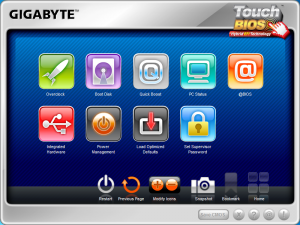BIOS and Overclocking
Of the two things that worried me about the Gigabyte Z68X-UD3H-B3, the main one was the BIOS. As manufacturers such as MSI, ASUS, and ASROCK have started promoting their UEFI-only BIOS, I wondered if Gigabyte had done the same, and if they had done it right.
As we can see, Gigabyte has done a terrific job with their UEFI Touch Bios. As stated, it looks much more prettier and easier to grasp a hold of than the traditional, bland BIOS screen:
Now we get to what was my second worry. If you recall, the Z68X-UD3H-B3 has lesser VRM’s than usual, and this gave rise to the notion of whether, or not the motherboard would be able to overclock to high frequencies while still remaining cool, quiet, and efficient. I decided to use Gigabyte’s Easy Tune 6 utility first to test this:
I managed to hit 4.5 GHz with little-to-no effort.
Thankfully, Gigabyte have retained their traditional blue-screened BIOS (instead of going just with UEFI and mingling those features from the old BIOS that cannot be ported over), with which I was able to overclock to 4.7 GHz:
Most people, especially enthusiasts and overclockers, are not totally on board with UEFI and still prefer the old BIOS functionality because it gives a sense of validity. That is not to say that there is anything wrong with UEFI. It is catered towards a novice user who can simply navigate and change settings without having to tackle, what can be, a confusing and daunting interface.
With everything said and done, the system is running perfectly fine, putting all of my fears to rest:
The big question about Gigabyte’s Touch BIOS is “why add the touch functionality”. My answer would be: “why not?”. While I agree that an extremely small percentage of people have touch-enabled screens, it is not as if the BIOS is made only for touch-screens. In my opinion, it is a cool little add-on for the niche market that possesses the technology for it, and I hope that Gigabyte extends the gimmicky feature onto products such as the iTouch, touch-enabled smartphones, and/or tablets, which would make Touch BIOS even more intriguing and easy to use.
NEXT: Final Words and Conclusion
Page 1: Introduction
Page 2: Specifications, Overview, and Features
Page 3: Closer Look, Specifications, and Benchmark Testing Platform
Page 4: CPU Benchmarks
Page 5: Computation and Productivity Benchmarks
Page 6: Storage and Peripheral Benchmarks
Page 7: Memory Benchmarks
Page 8: Gaming Benchmarks
Page 9: Overall System Benchmarks
Page 10: Z68 Chipset-Specific Benchmarks
Page 11: Temperature, Power, and Efficiency
Page 12: BIOS and Overclocking
Page 13: Final Words and Conclusion
 The SSD Review The Worlds Dedicated SSD Education and Review Resource |
The SSD Review The Worlds Dedicated SSD Education and Review Resource | 

